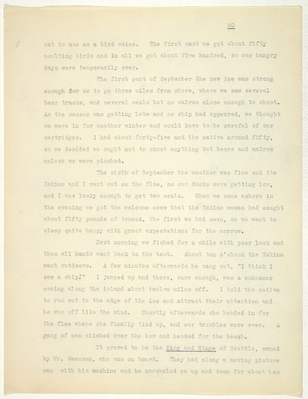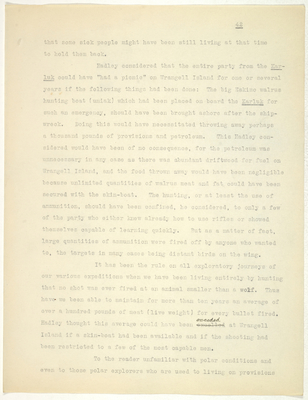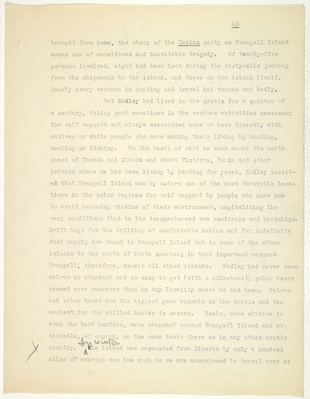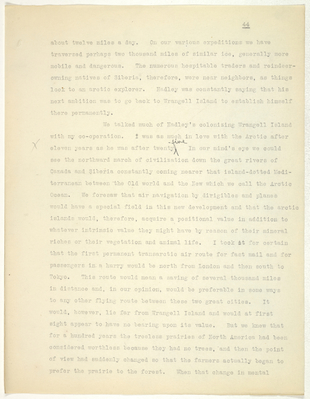Pages
stefansson-wrangel-09-26-001-056
40
out to use as a bird seine. The first cast we got about fifty moulting birds and in all we got about five hundred, so our hungry days were temporarily over.
The first part of September the new ice was strong enough for us to go three miles from shore, where we saw several bear tracks, and several seals but no walrus close enough to shoot. As the season was getting late and no ship had appeared, we thought we were in for another winter and would have to be careful of our cartridges. I had about forty-five and the native around fifty, so we decided we ought not to shoot anything but bears and walrus unless we were pinched.
The sixth of September the weather was fine and the Eskimo and I went out on the floe, as our ducks were getting low, and I was lucky enough to get two seals. When we came ashore in the evening we got the welcome news that the Eskimo woman had caught about fifty pounds of tomcod, the first we had seen, so we went to sleep quite happy with great expectations for the morrow.
Next morning we fished for a while with poor luck and then all hands went back to the tent. About ten o’clock the Eskimo went outdoors. A few minutes afterwards he sang out, "I think I see a ship!" I jumped up and there, sure enough, was a schooner coming along the island about twelve miles off. I told the native to run out to the edge of the ice and attract their attention and he was off like the wind. Shortly afterwards she headed in for the floe where she finally tied up, and our troubles were over. A gang of men climbed over the bow and headed for the beach.
It proved to be the King and Winge of Seattle, owned by Mr. Swenson, who was on board. They had along a moving picture man with his machine and he marshaled us up and down for about ten
stefansson-wrangel-09-26-001-057
41
minutes, taking films of us. When that was finished we went on board and started for Nome where we arrived .
(Signed) John Hadley.
We have been following Hadley's manuscript, but nearly every impression I have of Wrangell Island and the adventures and trials of Hadley and his companions comes not from his written account, though the manuscript is about five times as long as the part here printed, but from the stories he told me during the longwinter evenings, sometimes with excessive elaboration but more often in brief, disjointed sentences that would have been incomprehensible to a listener not thoroughly familiar with the whole background of polar environment, sailor ethics, and human nature as it manifests itself in remote isolation under circumstances different from the ordinary routine of sailor life.
Without a trace of callousness but with a recognition of the inevitable, Hadley believed that a second winter on Wrangell Island would have meant the death of all those not active and self supporting. This was not so much because the productive hunters would have refused to share what they got with the others, but rather because he believed both food and exercise to be necessary for health. It seemed to me that the lives of the whole party were saved by the King and Winge, but Hadley always maintained stoutly that himself, the Eskimos and probably two or three of the white men would have lived through the winter and through any number of successive winters. He believed also that these same people could have crossed to the mainland of Siberia, a hundred miles away, after the middle of the winter, and he said they would have done so except for the possibility
stefansson-wrangel-09-26-001-058
42
that some sick people might have been still living at that time to hold them back.
Hadley considered that the entire party from the Karluk could have "had a picnic" on Wrangell Island for one or several years if the following things had keen done: The big Eskimo walrus hunting boat (umiak) which had keen placed on board the Karluk for such an emergency, should have keen brought ashore after the shipwreck. Doing this would have necessitated throwing away perhaps a thousand pounds of provisions and petroleum. This Hadley considered would have been of no consequence, for the petroleum was unnecessary in any case as there was abundant driftwood for fuel on Wrangell Island, and the food thrown away would have keen negligible because unlimited quantities of walrus meat and fat could have keen secured with the skin-boat. The hunting, or at least the use of ammunition, should have been confined, he considered, to only a few of the party who either knew already how to use rifles or showed themselves capable of learning quickly. But as a matter of fact, large quantities of ammunition were fired off by anyone who wanted to, the targets in many cases being distant birds on the wing.
It has been the rule on all exploratory journeys of our various expeditions when we have been living entirely by hunting that no shot was ever fired at an animal smaller than a wolf. Thus have we been able to maintain for more than ten years an average of over a hundred pounds of meat (live weight) for every bullet fired. Hadley thought this average could hove been exceded at Wrangell Island if a skin-boat had been available and if the shooting had been restricted to a few of the most capable men.
To the reader unfamiliar with polar conditions and even to those polar explorers who are used to living on provisions
stefansson-wrangel-09-26-001-059
43
brought from home, the story of the Karluk party on Wrangell Island seems one of unrelieved and inevitable tragedy. Of twenty-five persons involved, eight had been lost during the sixty-mile Journey from the shipwreck to the island, and three on the island itself. Nearly every venture in hunting and travel had turned out badly.
But Hadley had lived in the Arctic for a quarter of a century, taking part sometimes in the various activities necessary for self support and always associated more or less directly with natives or white people who were making their living by hunting, sealing or fishing. On the basis of what he knew about the north coast of Canada and Alaska and about Victoria, Banks and other islands where we had been living by hunting for years, Hadley insisted that Wrangell Island was by nature one of the most favorable locations in the polar regions for self support by people who knew how to avoid becoming victims of their environment, capitalizing the very conditions that to the inexperienced are handicaps and hardships. Drift logs for the building of comfortable cabins and for indefinite fuel supply are found in Wrangell Island but in none of the other islands to the north of North America; in that important respect Wrangell, therefore, excels all other islands. Hadley had never seen walrus so abundant and so easy to get (with a skin-boat); polar bears seemed more numerous than in any locality where he had been. Walrus and polar bears are the biggest game animals in the Arctic and the easiest for the skilled hunter to secure. Seals, more elusive to even the best hunters, were abundant around Wrangell Island and obtainable, of course, on the same basis there as in any other arctic country. In winter the island was separated from Siberia by only a hundred miles of average sea ice such as we are accustomed to travel over at
stefansson-wrangel-09-26-001-060
44
about twelve miles a day. On our various expeditions we have traversed perhaps two thousand miles of similar ice, generally more mobile and dangerous. The numerous hospitable traders and reindeerowning natives of Siberia, therefore, were near neighbors, as things look to an arctic explorer. Hadley was constantly saying that his next ambition was to go bach to Wrangell Island to establish himself there permanently.
We talked much of Hadley's colonizing Wrangell Island with my co-operation. I was as much in love with the Arctic after eleven years as he was after twenty five In our mind's eye we could see the northward march of civilization down the great rivers of Canada and Siberia constantly coming nearer that island-dotted Mediterranean between the Old world and the New which we call the Arctic Ocean. We foresaw that air navigation by dirigibles and planes would have a special field in this new development and that the arctic islands would, therefore, acquire a positional value in addition to whatever intrinsic value they might have by reason of their mineral riches or their vegetation and animal life. I took it for certain that the first permanent transarctic air route for fast mail and for passengers in a hurry would be north from London and then south to Tokyo. This route would mean a saving of several thousand miles in distance and, in our opinion, would be preferable in some ways to any other flying route between these two great cities. It would, however, lie far from Wrangell Island and would at first sight appear to have no bearing upon its value. But we knew that for a hundred years the treeless prairies of north America had been considered worthless because they had no trees, and then the point of view had suddenly changed so that the farmers actually began to prefer the prairie to the forest. When that change in mental




